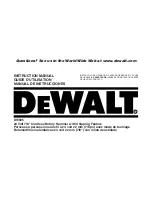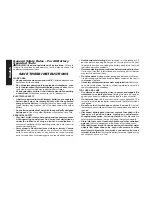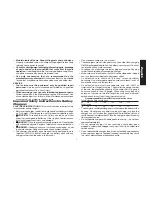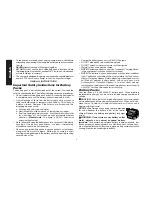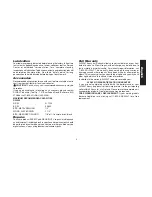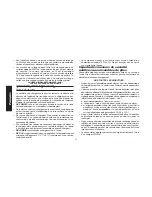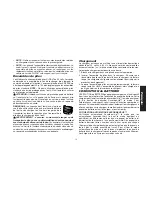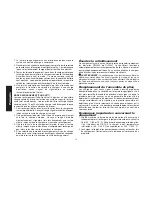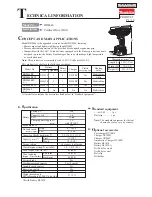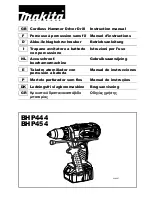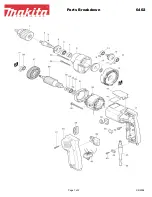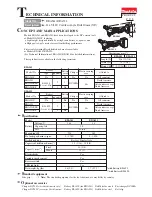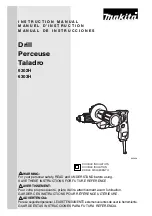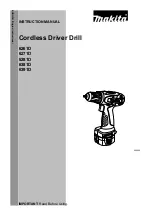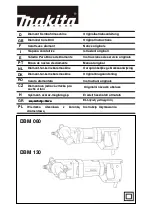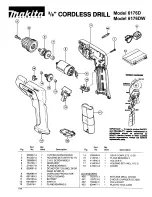
•
Maintain tools with care. Keep cutting tools sharp and clean.
Properly maintained tools, with sharp cutting edges are less likely
to bind and are easier to control.
•
Check for misalignment or binding of moving parts, breakage
of parts, and any other condition that may affect the tools
operation.
If damaged, have the tool serviced before using. Many
accidents are caused by poorly maintained tools.
•
Use only accessories that are recommended by the
manufacturer for your model
. Accessories that may be suitable
for one tool, may become hazardous when used on another tool.
SERVICE
•
Tool service must be performed only by qualified repair
personnel.
Service or maintenance performed by unqualified
personnel could result in a risk of injury.
•
When servicing a tool, use only identical replacement parts.
Follow instructions in the Maintenance section of this manual. Use
of unauthorized parts or failure to follow Maintenance Instructions
may create a risk of electric shock or injury.
Important Safety Instructions for Battery
Chargers
SAVE THESE INSTRUCTIONS:
This manual contains important safety
instructions for battery chargers.
•
Before using charger, read all instructions and cautionary markings
on (1) charger, (2) battery pack, and (3) product using battery pack.
•
CAUTION:
To reduce the risk of injury, charage only nickel
cadmium rechargeable batteries. Other types of batteries may
burst causing personal injury and damage.
•
DANGER:
120 volts present at charging terminals. Do not probe
with conductive objects. Danger of electric shock or electrocution.
•
DANGER:
If battery pack case is cracked or damaged, do not
insert into charger. Danger of electric shock or electrocution.
•
The charger and battery pack are specifically designed to work
together. DO NOT attempt to charge the battery pack with any
chargers other than the ones in this manual.
1
English
•
Do not expose charger to rain or snow.
•
These chargers are not intended for any uses other than charging
DeWalt rechargeable batteries. Any other uses may result in risk of
fire, electric shock or electrocution.
•
To reduce risk of damage to electric plug and cord, pull by plug
rather than cord when disconnecting charger.
•
Make sure cord is located so that it will not be stepped on, tripped
over, or otherwise subjected to damage or stress.
•
An extension cord should not be used unless absolutely
necessary. Use of improper extension cord could result in risk of
fire, electric shock, or electrocution.
•
An extension cord must have adequate wire size (AWG or
American Wire Gauge) for safety. The smaller the gauge number
of the wire, the greater the capacity of the cable, that is 16 gauge
has more capacity than 18 gauge. When using more than one
extension to make up the total length, be sure each individual
extension contains at least the minimum wire size.
Recommended Minimum AWG Size for Extension Cords
Total Extension Cord Length (feet)
25
50
75
100
125
150 175
Wire Gauge
18
18
16
16
14
14
12
•
The charger is ventilated through slots in the top and the bottom of the
housing. Do not place any object on top of charger or place the
charger on a soft surface that might block the ventilation slots and
result in excessive internal heat. Place the charger in a position away
from any heat source.
•
Do not operate charger with damaged cord or plug — have them
replaced immediately.
•
Do not operate charger if it has received a sharp blow, been
dropped, or otherwise damaged in any way; take it to an authorized
service center.
•
Do not disassemble charger; take it to an authorized service center
when service or repair is required. Incorrect reassembly may result
in a risk of electric shock, electrocution or fire.
Содержание DW005
Страница 1: ......



